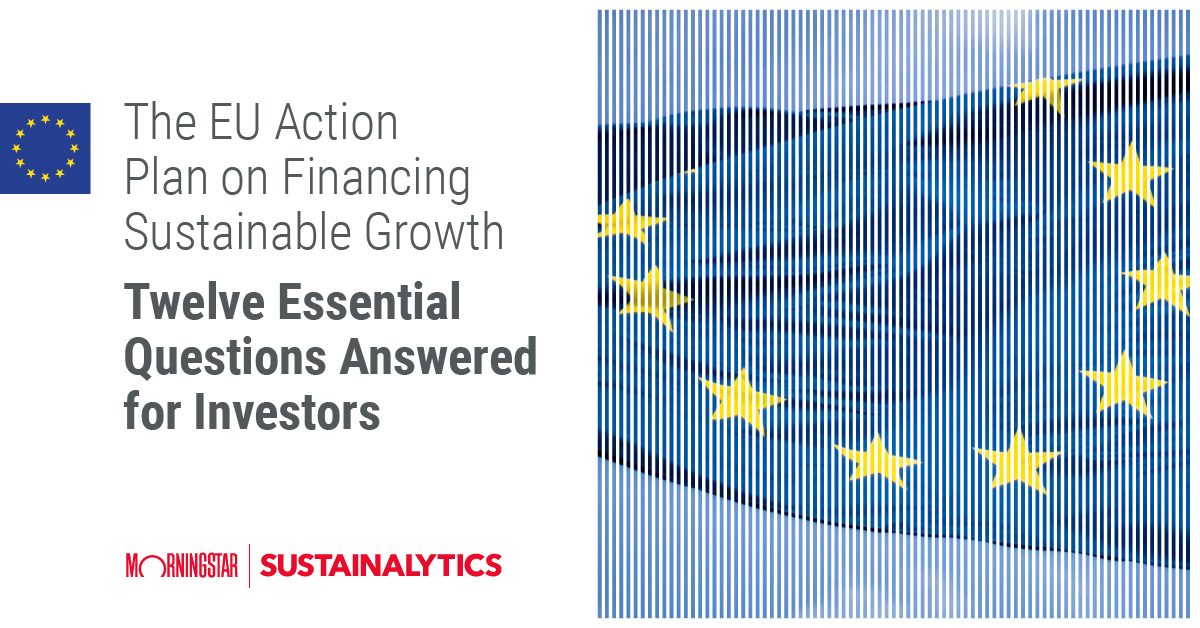The EU Action Plan for Sustainable Finance aims to put environmental, social, and governance (ESG) factors at the forefront of every investment decision, instead of viewing them as merely optional. As the Action Plan’s legislative framework is being formalized and implemented, deadlines for compliance with the new regulations are fast approaching. Yet, many investment firms may still need clarity on the regulations and terminology. For example: What is a sustainable investment? And what is the difference between a taxonomy-aligned activity and a taxonomy-eligible activity?
In this blog, we’re answering those questions and more as we demystify 10 key terms to help you better understand the EU Action Plan.
Key Term One: EU Taxonomy
The EU Taxonomy is one of the pillars of the regulatory framework of the EU Action Plan on Financing Sustainable Growth. In short, the Taxonomy aims to define which economic activities can be considered sustainable. For an economic activity to be considered sustainable, it must satisfy four overarching conditions and serve at least one of the six environmental objectives outlined in the EU Taxonomy as follows:
- Climate change mitigation
- Climate change adaptation
- Sustainable use and protection of water and marine resources
- Transition to a circular economy, waste prevention and recycling
- Pollution and prevention control
- Protection of healthy ecosystem
The EU Taxonomy regulation also introduces mandatory annual disclosure obligations for companies and financial market participants (FMPs), including taxonomy-compliant share of turnover, and capital expenditures and operating expenses aligned with the EU Taxonomy.
Key Term Two: Taxonomy Eligibility/Eligible Activities
Taxonomy-eligible activities are economic activities that are described and have technical screening criteria defined in the EU Taxonomy guidelines. In other words, taxonomy eligibility refers to whether an economic activity can be assessed and reported on. For example, electricity generated from wind and solar power is an eligible activity, while electricity generation from coal is not eligible. Eligibility alone does not indicate that the activity is sustainable. Currently, the list of eligible activities and screening criteria has only been adopted for two of the six environmental objectives outlined in the EU Taxonomy: climate change mitigation and climate change adaptation.
Key Term Three: Taxonomy Alignment/Aligned Activities
Taxonomy-aligned activities are eligible economic activities that are making a substantial contribution to at least one of the six environmental objectives while doing no significant harm to the remaining objectives. For an activity to be aligned with the taxonomy, it must meet the four overarching conditions outlined in the framework. The conditions are:
- Substantial Contribution: For an activity to be considered taxonomy aligned, it must make a substantial contribution, as determined by the technical screening criteria, to one of the six environmental objectives.
- Technical Screening Criteria: The technical screening criteria use strict thresholds to assess if an eligible activity is taxonomy-aligned. It is a binary pass/fail system, so there are no shades of grey. For example, carbon emissions from electricity generation must be less than 100g CO2e/kWh to be taxonomy-aligned.
- Do No Significant Harm: An activity that makes a substantial contribution to one objective is only considered sustainable if it does not do significant harm to any of the other five environmental objectives. For an activity to make a substantial contribution to climate change adaptation, for example, it must reduce material physical climate risks without adversely affecting other efforts, such as the protection and restoration of biodiversity and ecosystems.
- Minimum Safeguards: Taxonomy-aligned activities should be carried out in alignment with the OECD Guidelines for Multinational Enterprises and UN Guiding Principles on Business and Human Rights.
By meeting these conditions, the revenue, capital expenditures, and operating expenses for an economic activity can be considered taxonomy aligned.
Key Term Four: Sustainable Finance Disclosure Regulation (SFDR)
The SFDR sits at the core of the EU Action Plan and supplements the current rules governing financial product manufacturers and financial advisers in the European Union. Its aim is to increase transparency and comparability of ESG information for end investors and minimize greenwashing. By setting strict minimum disclosure standards, the SFDR encourages greater transparency from FMPs and financial advisors when it comes to their sustainability-related policies and objectives and seeks to raise the bar for investment products.
Key Term Five: Principal Adverse Impacts
Also referred to as PAIs, Principal Adverse Impacts refer to the negative sustainability effects that investments, decisions, or advice might have. PAIs are central to the SFDR and are key to understanding its objectives. Under the SFDR, financial market participants must disclose their exposure to certain PAIs.
Key Term Six: Markets in Financial Instruments Directive II (MiFID II)
The Markets in Financial Instruments Directive II is a legislative framework instituted by the European Union to regulate financial markets and improve protections for investors. MiFID II was rolled out in January 2018 as an update to the original MiFID, which went into effect in November 2007. Under MiFID II, asset managers must be able to offer advice regarding sustainable investments, EU Taxonomy alignment, and/or consideration of PAIs, for financial advisors to recommend their sustainability-focused products to end investors that have sustainability preferences.
Key Term Seven: Sustainable Investment
The SFDR defines sustainable investments as, “an investment in an economic activity that contributes to an environmental objective [or] a social objective … provided that such investments do not significantly harm any of those objectives and that the investee companies follow good governance practices.”1 The definition is notably broad, and it appears that FMPs are left to determine their own methodology for identifying sustainable investments (beyond what is already defined under the EU Taxonomy).
Key Term Eight: EU Benchmarks Regulation (EBR)
The EBR was developed to implement a common framework to ensure benchmarks are produced in a robust and reliable manner. It applies to benchmark administrators, contributors, and users of benchmarks. The EBR defines two climate benchmarks with similar objectives but differing levels of ambition. They are the EU Climate Transition Benchmark (EU CTB) and the EU Paris-Aligned Benchmark (EU PAB). Benchmark administrators are required to report on how key elements of their methodology reflect ESG factors for each benchmark or family of benchmarks. For benchmarks pursuing ESG objectives, administrators must explain how ESG factors are reflected in the benchmark’s characteristics.
Key Term Nine: European Union Climate Transition Benchmark
Under the EBR, an EU Climate Transition Benchmark (EU CTB) is a benchmark where the underlying assets are selected such that the resulting benchmark portfolio is on a decarbonization trajectory and is constructed in accordance with certain minimum standards outlined in amendments to the EBR. EU CTBs allow for greater diversification and serve the needs of institutional investors in their core allocation.
Key Term Ten: European Union Paris-Aligned Benchmark
Under the EBR, an EU Paris-Aligned Benchmark (EU PAB) refers to a benchmark where the underlying assets are selected in such a manner that the resulting benchmark portfolio’s GHG emissions are aligned with the long-term global warming target of the Paris Climate Agreement. To be labeled as an EU PAB, it must also be constructed in accordance with minimum standards outlined in amendments to the EBR. EU PABs are characterized by stricter minimum requirements and are designed for highly ambitious climate-related investment strategies.
Interested in learning more about the EU Action Plan and how its regulations will impact your organization? Download our ebook, The EU Action Plan on Financing Sustainable Growth: Twelve Essential Questions Answered for Investors where you’ll find more insight on the EU Action Plan, to whom it applies, and what it requires from institutional investors.
Morningstar Sustainalytics offers a comprehensive suite of high-quality research solutions for investors to leverage in order to meet the EU Action Plan requirements. Contact us to support you on your regulatory compliance journey.
Interested in learning more about the EU Action Plan and how its regulations will impact your organization? Download our ebook, The EU Action Plan on Financing Sustainable Growth: Twelve Essential Questions Answered for Investors where you’ll find more insight on the EU Action Plan, to whom it applies, and what it requires from institutional investors.
Morningstar Sustainalytics offers a comprehensive suite of high-quality research solutions for investors to leverage in order to meet the EU Action Plan requirements. Contact us to support you on your regulatory compliance journey.
References
1 The European Parliament and the Council of the European Union. 2019. Regulation (EU) 2019/2088 of the European Parliament and of the Council of 27 November 2019 on sustainability‐related disclosures in the financial services sector. November 27, 2019. https://eur-lex.europa.eu/legal-content/EN/TXT/?uri=celex%3A32019R2088





